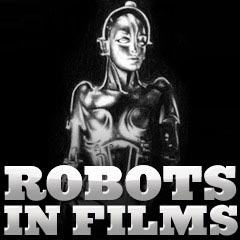
|
A Complete Illustrated History of Robots in the Movies 1979 to 1983 |
| Film/Year, Name of Robot and Film Description | ||||||||

|
One of the spaceship Nostromo's crew members, villainous and traitorous science officer Ash (Ian Holm) was an android, with intestinal tubing, an internal plastic skeletal structure, and milky white blood ("It's a robot! Ash is a goddamn robot!"). His secret corporate mission was to bring back the predatory Alien life-form from outer space for The Company, an evil organization that wanted the Alien for the nefarious Weapons Division. Ash was easily willing to sacrifice himself and the expendable Nostromo's crew in order for the Alien to survive. In his climactic death scene, Ash still talked with his head bashed off his body from a blow by a fire extinguisher, when he expressed his admiration for the Alien:
He also offered his final chilling words of warning: "I can't lie to you about your chances, but... (he cruelly smirked at them) you have my sympathies." Ash had made it diabolically clear that the ship's human crew were expendable and faced extraordinary odds in their coming battle against the uncaring and hostile machinations of Mother, the Company, and the Alien itself - all sinister entities "unclouded by conscience, remorse, or delusions of morality." With his last words, Ash was destructively unplugged. Parker blasted the remains of Ash's head and body with the incinerator gun, and the flames melted it down to a plastic skull. |
 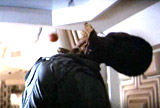   
|
||||||

|
The Black Hole (1979)
This Disney film (its first PG-rated film) set in the futuristic year of 2130 was considered by many to be a Star Wars knock-off. The spacecraft USS Palomino was returning to Earth, with its crew (headed by Dr. Alex Durant (Anthony Perkins)). On board was a robot known as V.I.N.cent (an acronym for "Vital Information Necessary CENTralized").
Nearby, the crew discovered a black hole and the long-lost, seemingly-abandoned spaceship the USS Cygnus. After boarding the vessel, they met crazed and obsessed scientist Dr. Hans Reinhardt (Maximilian Schell). He was aided by a number of robots that were staffing the spaceship:
B.O.B. revealed Dr. Reinhardt's deadly secret - when the human crew mutinied against him when Reinhardt refused to return to Earth, he lobotomized and "reprogrammed" all of the crew members, transforming them into faceless drones (based on Captain S.T.A.R. (Special Troops/Arms Regiment)) to serve him. |
 V.I.N.cent  B.O.B. (l), V.I.N.cent (r)   Maximillian  Sentinel Army Robots |
||||||

|
C.H.O.M.P.S. (1979)
Director Don Chaffey's last feature film was this family-oriented comedy about a robotic or computerized bionic dog - a spoof of crime fighting gadgetry and corrupt business executives. The film, with animated opening credits, got its title from the acronym for the mechanical dog, C.H.O.M.P.S. (Canine HOMe Protection System). It borrowed on the popularity of two popular movies at the time, Benji (1974) and the TV series and movie The Six Million Dollar Man (1973). The film's cute tagline was: "When it comes to home security, he's the top dog!" Another tagline stated: "He's a super canine computer - the world's great crime fighter (crossed out and replaced with BITER)!" This film was the first of a proposed film deal with Hanna-Barbera and American International Pictures (AIP) but when the picture failed at the box-office, the deal ended. The bionic dog (Benji), invented by 23 year-old Brian Foster (Wesley Eure), was based upon Brian's own scruffy pet Rascal (also Benji). He was a genius robotics-electronics worker at Norton Security Systems, a company producing devices to protect homes from invasion and prevent crime. The dog's special abilities included X-ray vision, super-strength, an ability to leap high distances, and vicious behavior (jumping through windows or walls, for example) after detecting a crime. Brian was trying to impress his boss Ralph Norton (Conrad Bain) and reestablish his job at the failing company. He was saved when the CEO's daughter Casey Norton (Valerie Bertinelli), his secret fiancee, came to his rescue. Most of the plot was about a rival company, headed by greedy Mr. Gibbs (Jim Backus), who had hired corporate spy Ken Sharp (Larry Bishop) to steal company secrets. The agent also employed two inept, bumbling and clumsy crooks, Bracken (Red Buttons) and Brooks (Chuck McCann), to steal the dog. The film ended with the demise of Mr. Gibbs, the capture of the criminals stealing plans, the near death of CHOMPS, and the manufacture of many more CHOMPS. |
   
|
||||||

|
(H.G. Wells') The Shape of Things to Come (1979, Canada)
Director George McCowan's cheaply-made sci-fi adventure thriller was only slightly based on H.G. Wells' 1933 futuristic novel, and a remake (self-declared "sequel") of the earlier 1936 movie. It was really an entirely different story with different characters and settings, and very similar to Battlestar Gallactica (1978) and the TV series Buck Rogers in the 25th Century (1979-1981). It was another weak attempt to duplicate the success of George Lucas' Star Wars phenomenon and ride the wave. The rip-off film reinterpreted the novel and speculated that the future, dystopic, high-tech world, unsurprisingly, would have spaceships, laser beams, and of course, evil robots. In the story, a nuclear apocalypse ("Robot Wars") and Earth's devastation by pollution had caused its inhabitants to move to the Moon, and live in an insulating, glass-like, domed bubble. The occupants of New Washington were threatened by radioactive rays, and required drug medication (Radic-Q2) to survive radiation sickness. Unfortunately, the medicine was in the hands of evil, blackmailing, tyrannical Emperor Omus (Jack Palance) (known as "The Robot Master"), always wearing a giant golden medallion attached to a flowing purple cape, who controlled distant planet Delta Three where the life-saving drug was manufactured. In the film's opening, he deliberately crashed a drug cargo spaceship (piloted by a robot) into the dome. A group of rebels ventured to his planet in an advanced starship (the Star Streak), assisted by Delta Three's female leader Nikki (Carol Lynley) to defeat Omus and save humanity by procuring more medication:
"Sparks" (Mark Parr, voice by Greg Swanson), was Kim's reconditioned robot that emitted sparks at random. Sparks was reconstructed from the spare parts of the robot destroyed in the freighter crash. During the concluding conflict on the planet Delta 3, Sparks ordered Omus' army of six robots to suddenly turn on their master, thereby allowing Jason and the others to flee the control room, leave on their starship, and destroy Omus and his robots on his planet. |
 Cargo Ship Robot    Kim with "Sparks"  One of Omus' Robots  The Death of Omus with Two of His Robots |
||||||

|
Star Odyssey (1979, It.) (aka Sette uomini d'oro nello spazio, or Seven Gold Men in Space)
This was another low-budget Italian space opera - considered by some as a rip-off of Star Wars (1977), again from director Alfonso Brescia, who also directed War of the Planets (1977, It.), and War of the Robots (1978). The futuristic plot was familiar - it was set in the year 2312 on Earth (Sol 3), which had just been sold off at a space auction (for the Lords of the Galaxy). The highest bidder was evil, gold-faced despot Lord Kess of Kobal who had purchased Sol 3. His plan was to enslave billions of 'dark-skinned' humanoids (and profit from their future sale), enforced with an alien cyborg-android army of stormtroopers (all with golden Prince Valiant or Dutch Boy haircuts and silver suits). Earth's Command Base military officer, Lieutenant Oliver "Hollywood" Carrera (Nino Castelnuovo) called upon bald psychic scientist, Professor Mauri (Ennio Balbo), to defend the planet. Mauri sent his pretty niece Irene (Yanti Somer) to assemble a team, to recruit:
The awful film ended with a perfunctory, primitive video game-like Star Wars space battle. |
 Alien Cyborg-Android Army Members  Hercules IV    Robots: Tiki and Tilly |
||||||

|
Star Trek: The Motion Picture (1979)
The other films in the first series with original crew were:
The first Star Trek film featured V'Ger - a living, mystical machine/planet ("a living machine...a conscious living entity") that was menacing and appeared to be threatening to destroy Earth while seeking its creator. It was revealed that the cryptically-named V'Ger was formerly the unmanned scientific space probe and transmitter named Voyager 6 that was launched by NASA from Earth in the 20th century (with a mounted plaque that read VOYAGER VI), more than 300 years earlier. The sentient machine V'Ger memorably abducted sexy Deltan and USS Enterprise navigator Lieut. Ilia (Persis Khambatta) and replaced her with a perfect mechanical 'doppelganger' android/replicant of the dead Starfleet officer:
According to the robot, V'Ger was traveling to Earth ("the third planet of the solar system directly ahead") "to find the creator, to join with him...V'Ger and the creator will become one...The creator is that which created V'Ger...V'Ger is that which seeks the creator." The android probe ("a programmed mechanism") was basically undetected as artificial until scanned in the Enterprise sick bay, where it was discovered that it was composed of micro-miniature hydraulics, sensors, molecule-sized microprocessor chips, and an osmotic micropump. Spock (Leonard Nimoy) surmised that Ilia's memories had also been replicated, meaning "her feelings of loyalty, obedience, friendship might all be there" - the probe was "the key to the aliens" - if those memories could be revived. Commander Willard Decker's (Stephen Collins) love interest in Ilia from a previous romantic relationship resulted in his offering himself up to 'merge' physically with V'Ger (symbolically through its android probe) - the merging of human and machine took place in a dazzling, swirling shower of light, creating a new glowing alien entity or non-corporeal life form ("We witnessed a birth. Possibly a next step in our evolution"), from which the USS Enterprise emerged - unscathed.
|
 Lieut. Ilia   Replacement Android Ilia   V'Ger |
||||||

|
Unidentified Flying Oddball (1979) (aka The Spaceman and King Arthur)
Released by Disney, and the final (second) film of director Russ Mayberry, this light-weight family sci-fi adventure-comedy was inspired by Mark Twain's A Connecticut Yankee in King Arthur's Court, published in 1889. Its title was a spoof on the acronym UFO ("Unidentified Flying Object"). The simplistic movie was billed as a "sixth century space adventure." A quirky NASA astronaut and robot-maker Tom Trimble (Dennis Dugan), due to an accident on the launch pad during an electrical storm, sent both his own doppelganger double, a trusty android robot pilot named Hermes (also Dugan) - and HIMSELF, back in time in his faster-than-light spacecraft Stardust. The space shuttle traveled to the Dark Middle Ages, landing in Cornwall, Devonshire England in 508 AD, at the time of King Arthur's Camelot, where he was captured. While romancing pretty Alisande (Sheila White), he was also compelled to save Camelot from villainous knight Sir Mordred (Jim Dale), who was conspiring to oust King Arthur (Kenneth More), and he would also expose magician Merlin (Ron Moody) as fraudulent.
|
  Tom Trimble and Robotic Doppelganger Hermes  
|
||||||

|
Galaxina (1980)
William Sachs' science-fiction comedy parody (of Alien (1979) and Star Wars (1977)) set in the year 3008 featured a sexy, mostly-mute female android/robot pilot named Galaxina (Playboy's Playmate of the Year Dorothy Stratten in her last film before her murder in 1980 by her estranged husband). Galaxina was on board the interstellar patrol spaceship Infinity of the United Intergalactic Federation. In the film's trailer, she was described as a heavenly body in a backless, skin-tight white body suit and seated in a glowing chair - "transistorized and computerized to lead her space buddies across the farthest reaches of fantastic adventure." She possessed a small keypad in her left palm through which she could reprogram herself. She also had a built-in security electro-shock system (force field) preventing anyone from touching her. |
 
|
||||||

|
Saturn 3 (1980)
In an experimental food research station underground on moonbase Saturn 3, one of Saturn's moons, scientist couple Major Adam and lover/assistant Alex (Kirk Douglas and Farrah Fawcett) - in their Edenesque setting, were threatened by a menacing, superstrong "Hector" model robot, noted for saying: "I am not malfunctioning. You are." Hector was a headless, evil 7 foot-tall robot with steel musculature for his chest, lethal pincher hands, other crome-plated body parts, and red and blue plastic tubes with hydraulic fluid winding around its body cavity. Mounted between the robot's two shoulders was a small two-eyed, binocular lighted head component (like a closed-circuit surveillance camera at the end of a metal, jointed shaft) that was able to move about. The android's living, organic brain (stored in a glass tank) was reprogrammed by drug-using, lustful psychotic pilot Benson (Harvey Keitel) who used a plug-in jack at the back of his neck (surgically implanted into his spinal cord) to control the robot's actions - mostly to rape Alex (he had earlier asked her: "You have a great body. May I use it?"). By film's end, Hector killed Benson and wore his stripped-off face like a mask! |
  
|
||||||

|
Clash of the Titans (1981)
Director Desmond Davis' spirited, old-fashioned romantic adventure with a big-name cast was based upon ancient Greek mythology - the tale of Greek hero Perseus. It was the last feature film of special-effects, stop-motion master Ray Harryhausen, and his only film in the post-Star Wars era. He displayed impressive effects, however: a two-headed dog-wolf, a giant vulture, three giant scorpions, Pegasus the flying horse, Medusa the Gorgon with hair of snakes (and a stony glare), and the mechanical owl creature named Bubo. Bubo was a chirping, cute metallic golden owl that sounded like R2-D2 - essential to the film if it was to appeal to juveniles who had seen Star Wars (1977) with its two robotic droids. Its chirping sounded like a cuckoo-clock's bird. With spinning eyes, and a rotating head, its beak moved when it spoke. To overcome numerous obstacles in his quest, Perseus was aided by elderly poet/playwright Ammon (Burgess Meredith), and by a gift from Athena - she had instructed Hephaestus (Pat Roach) to build a golden replica of her pet owl Bubo. When Bubo flew to Perseus to assist him, Ammon asked about Bubo's speaking: "Do you understand all those clicks and wheezes?" Perseus affirmed that he did: "Perfectly clear to me." Ammon replied: "It's another gift from the gods, like the sword and the helmet." The live-action family fantasy pitted Perseus (Harry Hamlin), the illegitimate mortal son of Zeus (Laurence Olivier) against a number of obstacles (magic including solving a deadly riddle, monsters including three flesh-eating witches of Stygian, and the gods). With a magical sword, invisibility helmet and shield, he strove to free imprisoned Princess Andromeda (Judi Bowker) (and win her hand) from the giant sea monster known as the Kraken (the last of the powerful Titans). His aim was to defeat her former betrothed Calibos (Neil McCarthy), who had been turned into a deformed and monstrous satyr in the swamp. |
   
|
||||||

|
Heartbeeps (1981)
This goofy sci-fi romantic comedy bombed at the box office, and was critically assailed. Val-Com 17485 (Andy Kaufman) - a valet robot dressed in a three-piece suit and bowtie, and hostess robot Aqua-Com 89045 (Bernadette Peters) with copper-wired hair, were both featured as two plastic, household renegade robots brought into a robot repair shop. Val fell in love with Aqua as they were both awaiting repairs. They both decided to run away, with cigar-chomping, wise-cracking comedy robot named Catskill (voice of Jack Carter), into the outdoorsy woods by hijacking a van, where they were hunted down by a crime-stopping, fire-spewing, tank-like Crimebuster Deluxe robot (voice of Ron Gans). As a result of their romance, they also had a tread-wheeled robot baby named Phil (voice of Jerry Garcia of the Grateful Dead), created or built from their own spare body parts. They had to return to the warehouse when their batteries went dead. |
 Val  Aqua  Catskill  Crimebuster  Phil |
||||||
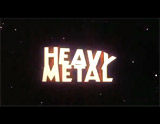
|
Heavy Metal (1981, US/Can.)
The fantasy graphics of the adult-oriented, late 70s comic book Heavy Metal inspired this animated, exploitative pop-cult film of six sci-fi/erotica, inter-related episodic segments (interwoven and framed by another story). The tales were accompanied by heavy metal hard rock. The animation was rated R for violence, sex, nudity (animated!), profanity and vulgarity. The entire film told of an evil, glowing sentient green orb or meteorite, called the Loc-Nar, in inter-related vignettes. This was an 'adult' underground cartoon that was more adolescent and juvenile than anything else, with graphic, teen-oriented depictions of drugs, taboo-breaking sex, disrobing nude women (with large breasts) viewed as sex-objects, sex-toy robots, fantasy sword-and-scorcery, and gory violence. In the 5th segment, "So Beautiful, So Dangerous," red-headed Pentagon secretary Gloria (voice of Alice Playten) had sex with a robot (voice of John Candy) after being kidnapped onto an alien ship. Nude, she laid back next to the robot smoking a cigarette, when she exclaimed:
|
 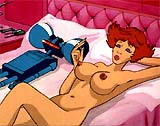 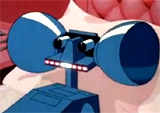 
|
||||||

|
Android (1982)
In the year 2036, obsessed and eccentric, Frankensteinish research scientist Dr. Daniel (Klaus Kinski) in a satellite laboratory on a remote space station in deep space, worked with his 5 year-old shy, assistant prototypical android Max 404 (scriptwriter Don Keith Opper). He was carrying out illegal research (androids were outlawed on Earth). The film drew parallels to Rotwang's creation of the destructive "Fake" Maria in Metropolis (1927), with footage from the film. In his spare time, coming-of-age Max engaged in learning about 20th century humans by playing computer games, watching old movies, reading sex manuals, and listening to rock 'n' roll and soul music. In order to activate and complete a perfect, upgraded blonde-haired female android model named Cassandra-1 (Kendra Kirchner) that would render Max obsolete, Dr. Daniel needed the life essence of a real female. Android Max was worried that he would be deactivated:
A runaway spaceship with three fugitives arrived and docked at the space station, including:
Daniel wanted to use Maggie as a model and sex-electrical power source (Maggie incredulously said: "You want to hook me up to this robot and stimulate me!"). When the sexual chemistry from Maggie and Max sparked life into Cassandra, she came alive. In the film's twist ending, it was revealed that Dr. Daniel was also a robotic android when his head was ripped off by Max and Cassandra during a brief struggle. Then the film concluded with Max and Cassandra returning to Earth posing as Dr. Daniel and his assistant. |
 Dr. Daniel with Max 404  Cassandra-1  Android Dr. Daniel |
||||||

|
Ridley Scott's classic cult film told about four android 'replicants' (robotic NEXUS-6 models, designed by the Tyrell Corporation as the latest and best technological products), created with limited life spans of four years (a built-in fail-safe mechanism in case they became too human - "more human than human") with an abrupt termination date. Replicants were bio-engineered life forms virtually indistinguishable from humans, but with increased capacities of strength and agility. They were rated poor on emotional responses (measured by the Voigt-Kampff test).
The genetically-engineered biorobotic renegades (derogatorily called "skin-jobs") were escapees to Earth (Los Angeles in the year 2019) from enslaving conditions on an Off-World outer planet, looking for their creator to prolong their short lives. Their four year shelf-life limited them from conducting a replicant rebellion, running amok, or more positively, from displaying the most human of traits. But they were capable of developing feelings comparable to or better than most humans and wished to find immortality beyond their short life span. Two other replicants included:
|
 Leon  Zhora  Pris  Roy Batty  Rachael |
||||||

|
Tron (1982)
Walt Disney Production's visually-astonishing, state of the art (at its time) landmark film with Wendy Carlos' unique score was the first true CGI-animated film. There were astounding scenes, such as a breathtaking, gladiatorial competitive race in an arena - the light cycle sequence between curved racing pods. In the story, computer programmer/hacker Kevin Flynn/Clu (Jeff Bridges) was literally transported ('digitalized'), by malevolent Master Control Program or "MCP" (voice of David Warner), into the grid-lined, neon-glowing, 3-D pixelized world inside an evil corporation's mainframe ENCOM computer, where programs lived and worked. When Kevin first took the arcade grip controls within the computer, he experimented with a Recognizer, a pursuit and attack vehicle. Recognizers functioned as lethal enforcers of the MCP's tyrannical rule, which took care of renegade programs by capturing them, or by 'stomping' on them and crushing them with its pylon legs. Literally, a Recognizer was a hovering, aerial security transport vehicle (with a central control cockpit for the crew and a passenger compartment) with two massive pylon legs, used by the MCP's army. With his user powers, Flynn accidentally reactivated a Recognizer craft, reassembled it (although one of its triangular pylon leg-foot supports fell off, causing navigation difficulties), and piloted it to another part of the system, where he crashed and destroyed it. |
 Kevin/Clu (Jeff Bridges)   Recognizer |
||||||

|
This film flop from director Richard Lester was the third of a series of Superman films from 1978 to 2006. In the film's climax, Vera Webster (Annie Ross), the sister-partner of villainous multimillionaire Ross Webster (Robert Vaughn), was monstrously transformed by an intelligent supercomputer, hidden in a cave within the Grand Canyon. As she fled from the computer's control room, the supercomputer grabbed her and sucked her back inside. Circuitry appeared under her skin, charges of electricity and power passed into her body, lighting it up, and she was made part of the machine. She was turned into a hulking, fright-wigged robotic cyborg zombie, that used power rays on the others to subdue and immobilize them. Shortly later, after Superman was able to cause the supercomputer to self-destruct and disintegrate, she was returned to normal. |
  
|
||||||